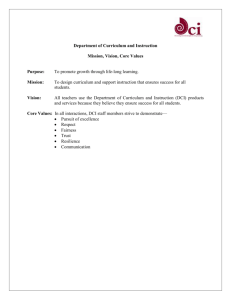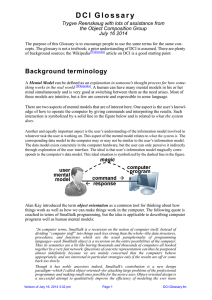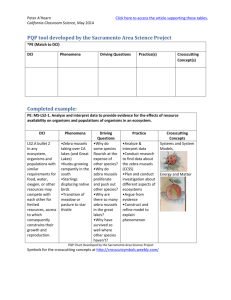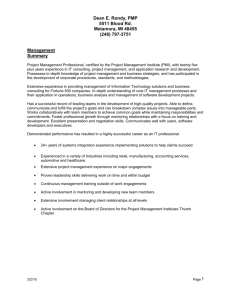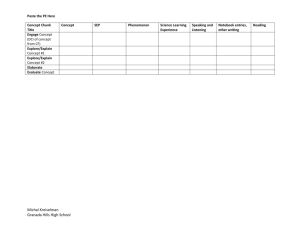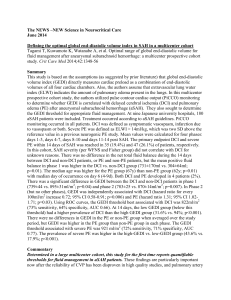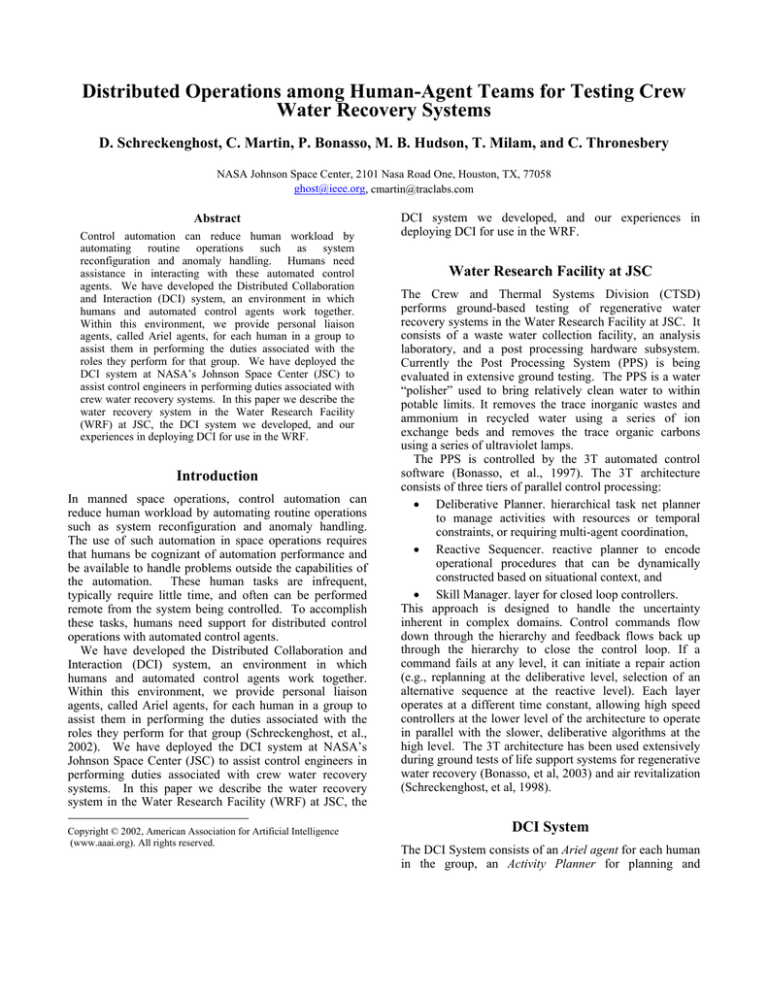
Distributed Operations among Human-Agent Teams for Testing Crew
Water Recovery Systems
D. Schreckenghost, C. Martin, P. Bonasso, M. B. Hudson, T. Milam, and C. Thronesbery
NASA Johnson Space Center, 2101 Nasa Road One, Houston, TX, 77058
ghost@ieee.org, cmartin@traclabs.com
Abstract
Control automation can reduce human workload by
automating routine operations such as system
reconfiguration and anomaly handling. Humans need
assistance in interacting with these automated control
agents. We have developed the Distributed Collaboration
and Interaction (DCI) system, an environment in which
humans and automated control agents work together.
Within this environment, we provide personal liaison
agents, called Ariel agents, for each human in a group to
assist them in performing the duties associated with the
roles they perform for that group. We have deployed the
DCI system at NASA’s Johnson Space Center (JSC) to
assist control engineers in performing duties associated with
crew water recovery systems. In this paper we describe the
water recovery system in the Water Research Facility
(WRF) at JSC, the DCI system we developed, and our
experiences in deploying DCI for use in the WRF.
Introduction
In manned space operations, control automation can
reduce human workload by automating routine operations
such as system reconfiguration and anomaly handling.
The use of such automation in space operations requires
that humans be cognizant of automation performance and
be available to handle problems outside the capabilities of
the automation. These human tasks are infrequent,
typically require little time, and often can be performed
remote from the system being controlled. To accomplish
these tasks, humans need support for distributed control
operations with automated control agents.
We have developed the Distributed Collaboration and
Interaction (DCI) system, an environment in which
humans and automated control agents work together.
Within this environment, we provide personal liaison
agents, called Ariel agents, for each human in a group to
assist them in performing the duties associated with the
roles they perform for that group (Schreckenghost, et al.,
2002). We have deployed the DCI system at NASA’s
Johnson Space Center (JSC) to assist control engineers in
performing duties associated with crew water recovery
systems. In this paper we describe the water recovery
system in the Water Research Facility (WRF) at JSC, the
Copyright © 2002, American Association for Artificial Intelligence
(www.aaai.org). All rights reserved.
DCI system we developed, and our experiences in
deploying DCI for use in the WRF.
Water Research Facility at JSC
The Crew and Thermal Systems Division (CTSD)
performs ground-based testing of regenerative water
recovery systems in the Water Research Facility at JSC. It
consists of a waste water collection facility, an analysis
laboratory, and a post processing hardware subsystem.
Currently the Post Processing System (PPS) is being
evaluated in extensive ground testing. The PPS is a water
“polisher” used to bring relatively clean water to within
potable limits. It removes the trace inorganic wastes and
ammonium in recycled water using a series of ion
exchange beds and removes the trace organic carbons
using a series of ultraviolet lamps.
The PPS is controlled by the 3T automated control
software (Bonasso, et al., 1997). The 3T architecture
consists of three tiers of parallel control processing:
• Deliberative Planner. hierarchical task net planner
to manage activities with resources or temporal
constraints, or requiring multi-agent coordination,
• Reactive Sequencer. reactive planner to encode
operational procedures that can be dynamically
constructed based on situational context, and
• Skill Manager. layer for closed loop controllers.
This approach is designed to handle the uncertainty
inherent in complex domains. Control commands flow
down through the hierarchy and feedback flows back up
through the hierarchy to close the control loop. If a
command fails at any level, it can initiate a repair action
(e.g., replanning at the deliberative level, selection of an
alternative sequence at the reactive level). Each layer
operates at a different time constant, allowing high speed
controllers at the lower level of the architecture to operate
in parallel with the slower, deliberative algorithms at the
high level. The 3T architecture has been used extensively
during ground tests of life support systems for regenerative
water recovery (Bonasso, et al, 2003) and air revitalization
(Schreckenghost, et al, 1998).
DCI System
The DCI System consists of an Ariel agent for each human
in the group, an Activity Planner for planning and
coordinating human activities, an Event Detection
Assistant (EDA) for detecting simple domain events, a
Complex Event Recognition Architecture (CERA) for
capturing complex domain events, and the DCI
infrastructure required for these components to
communicate using CORBA. Each Ariel agent provides
services to assist its user in performing the duties
associated with his or her job. The DCI System has been
implemented using Java 1.4.2, Allegro Lisp 6.1, and
CORBA ORB implementations JacORB 1.4.1 and ILU
2.0b1. In this section we describe the services and
capabilities implemented for the control engineers in the
WRF.
Notification and Alerting. The Ariel Notification
Service encodes communication protocols to notify
distributed team members when important events or
operations occur. Protocols must be adapted to account for
the fact that an individual may hold multiple roles, that
roles can be reassigned dynamically, and that changes in
role alter the information requirements of the human.
Notices of user state changes (e.g., location changes) are
exchanged among the liaison agents to support group
coordination. The EDA detects simple events (e.g.,
thresholds, triggers) and publishes them to the liaison
agents. CERA from I/Net (Fitzgerald, et al., 2003)
captures complex event sequences associated with
operational situations and anomalies. CERA applies
language recognition principles to detect event patterns
with complex temporal and hierarchical relationships
among them. These event sequences also are published to
the Ariel agents as situation summaries. The Notification
Service within the Ariel agent is responsible to filter all
events received by the agent. The User Interface Service
then determines how to present notices of interest to the
user. These services use protocols encoded as rules
describing the conditions for identifying the notices of
interest to the agent’s user and directives for how to
present the notice to the user. These rules include the use
of domain ontologies to describe conditions and directives.
The user attention is shifted to important notices by
changing the notices icon in the DCI toolbar (Figure 1).
To view the new notices, the user selects the notice icon in
the toolbar and the notice viewer will be displayed (Figure
2). Notices can also be sent via a pager or via email.
Figure 2. DCI Notice Viewer
Schedule
Figure 3. DCI Schedule
Notices
Figure 1. DCI Toolbar
Activity Coordination using Shared Plans. We use a
centralized plan built by a hierarchical task net planner to
coordinate the actions of humans performing space
operations. We chose to use a centralized planning
approach to ensure activities are assigned to accomplish all
operational goals, to help prevent humans from issuing
conflicting commands, and to coordinate the handover
between manual and automated tasking. The Activity
Planner assigns roles, builds the activity plan, and tracks
progress in completing the plan. When activities are not
completed successfully, the Activity Planner builds
another plan to accomplish the operational goals, including
reassigning tasks. The Task Status Service for each Ariel
agent determines its user’s progress in completing the
assigned activities, informs the Activity Planner about task
progress, and notifies its user when her schedule changes.
The Ariel agent determines task completion either using
direct evidence obtained through computer-mediated
manual tasks or indirect evidence based on the user's
location from the Location Service. In the WRF, the
planner is used primarily to manage anomaly handling
activities. As shown in Figure 3 above, the schedule of the
person responsible to fix the problem is updated
automatically with the anomaly handling task (“restore”
task in red text).
Group View
Figure 3. DCI Schedule
Location Tracking. The Location Service of the Ariel
agent determines its user's location information for use in
tracking the completion status of crew activities, in
determining how to notify the crew of events, and in
maintaining awareness of a distributed group via a group
awareness display. This service interprets sensed user
location from computer login/logout events to determine
the user's physical location and whether the user is online
or offline. Computer locations are mapped to the closest
physical location milestone (e.g., lab, office) using a
location ontology. The user is considered online when a
login event is received. The user is considered offline
when a logout event is received indicating the user has no
active session, or when the last active session times out.
The user's physical and cyber-location are combined to
assess availability and accessibility (i.e., user presence). A
group awareness display can be access from the DCI
toolbar that provides a view of the location, role, and
schedule of all users in the operational group (Figure 4
above). In this example, Carroll was recently logged into
his Ariel system in his Building 32 office. As indicated by
his grayed out picture, however, he is no longer “online”
with his agent.
Related Work
The Ariel agents of the DCI system resemble the Friday
agents in the Electric Elves project (Scerri, et al., 2002) in
that both types of agents aid humans interacting in groups.
The Friday agent were intended to assist professors and
students at the University of Southern California in
conducting their daily business. These Friday agents
scheduled meetings, arranged for speakers at those
meetings, scheduled rooms for the meetings, and made
reservations for luncheons. The Ariel agents differ from
the Friday agents, however, in that the Ariel agents aid
interaction among humans and automated control agents
while the Friday agents only aid interaction among
humans.
Within NASA, the Mobile Agent Project (Sierhuis, et
al., 2003) has developed both proxy agents and personal
agents for use in a Mars analog project. In this project, the
mobile agents assist humans in collecting and organizing
geological and biological data during a planetary traverse.
As with the Friday agents from the Electric Elves Project,
a fundamental difference between the Mobile Agents and
the Ariel agents is that the Ariel Agents are designed to
assist interaction among teams of humans and automated
control agents, while Mobile Agents are intended to aid
human interaction.
Also within NASA, the Personal Satellite Assistant
(PSA; Bradshaw, et al., 2000), is a robotic device designed
to assist astronauts with communications and remote
monitoring. The PSA has been simulated in a testbed at
the Ames Research Center. Like the Ariel agent, the PSA
is intended to free the astronauts from routine tasks and
increase the level of crew autonomy. The focus of the
PSA, however, is on technology for embodied agents
while the focus of the Ariel agent is on software agents.
Deployment of DCI in the Water Research
Facility
In this section we discuss our experiences in deploying the
DCI system for the control engineers in the WRF. We
describe how the operational protocols have been changed
by using the DCI system, how the DCI system supports
distributing operations, how DCI has evolved to provide
more stable, efficient operations, and an example of how
we have evaluated the DCI system.
Operational Protocols
The control engineers in the water lab fulfill three roles:
Prime, Backup, and Coordinator. The Prime is the person
responsible to handle anomalies that cannot be handled by
the control automation. This requires going to the water
lab where both the control software and the life support
equipment reside. The Backup is responsible to handle
problems when the Prime cannot. The Coordinator is the
most knowledgeable about the PPS system and is
responsible to ensure the overall health of the PPS. Each
week the roles of Prime and Backup shift among the
control engineers. The role of Coordinator, however, is
assigned to a single person and does not change.
For previous water tests, the Prime would bring up data
monitoring displays when in his office to watch for
problems. When out of the office, he would try to check
these displays every four hours throughout the day. He
was on-call overnight, if someone noticed a problem. But
there was no automatic way of detecting and notifying him
of a problem. When a problem occurred, the phone was
used to coordinate group members.
The availability of the DCI system has changed these
protocols. Now the Prime brings up his DCI system when
in the office. His Ariel agent monitors for events and
notifies him when something important happens. The
agent also captures the important situation summaries for
his inspection after the fact. If the person is offline, his
agent will page him when an important event occurs. His
agent can assign him tasks when problems occur, and does
this with knowledge of his availability based on his
schedule. If he cannot respond in time, the DCI Activity
Planner will reassign the responsibility to handle the
situation to the Backup automatically and will notify both
the Backup and Prime of the task reassignment. The
phone is still used for coordination in cases where a group
member cannot access his DCI system.
Once we deployed DCI in the WRF, we revised the new
protocols in the following ways:
• DCI Shutdown: we added notices sent to all users
of the DCI system to let them know when the DCI
system is about to be shutdown and restarted. This
ensured that users who were interacting with their
agents were given warning that the system was
about to become temporarily unavailable.
• Notify critical anomalies on multiple channels, such
as email and paging, since we are not sure which
are accessible to the person when offline.
• Provide both computer-based and other ways to
confirm or deny acceptance of tasks assigned for
critical anomaly handling (e.g., reply via pager).
• Do not eliminate existing coordination techniques
that work well, such as the telephone. For example,
we saw an over-reliance on automatic paging which
prevented directly calling engineers.
Changes for Distributed Operations
The DCI system improves the ability to support distributed
control operations, permitting remote access to the PPS
from offsite offices and home. In this section we discuss
the changes we made to the DCI system during
deployment to better support distributed operations.
Notification. As the operations group is distributed and
potentially unavailable at times, it becomes important to
support asynchronous notification. For our group, we use
pagers for high saliency, asynchronous notification. We
initially tried to use a single pager for the entire group,
which was passed with the assignment of the Prime role.
Our first PPS anomaly (Loss of Communication)
emphasized the need for pagers for all roles. During that
anomaly, the battery failed in the single pager we had. The
anomaly occurred around 5:30 AM. Had the Backup had a
pager, he would have received a notice well before going
to work. With only a single pager, however, the
notification was not received by the Prime or the Backup
until they got to work and logged into the DCI system.
Activity Planning. Another aspect of distributed
operations is building plans for remotely assigned tasks.
As mentioned above, the DCI system manages human
tasks using an automated planner. During the course of
using the DCI system we learned that a significant portion
of the task duration is travel time to the water lab (up to
50% in some cases). We also learned that when notifying
a person about a new task assignment it was helpful to
clearly identify the task name along with some background
information about why the task is needed (e.g., the
anomaly to be handled or an indication that Prime did not
respond). In anomaly cases, the replanning that results in
this new task assignment happens automatically because
the assigned person does not respond in a timely manner.
In some cases, however, the Coordinator may need to
manually activate replanning from a remote location.
During deployment we developed a simple user interface
to remotely activate replanning. From this interface the
Coordinator can either create a new plan (invoke a reset
and re-plan) or update an existing plan by performing a replan. This was primarily used to build a new plan when
user roles were changed each week.
Location Tracking. The DCI system tracks the
location of group members to aid in group awareness as
well as to determine whether members are online or not for
notification. For coordination in the water lab, we provide
a group awareness display that shows the locations and
activities of all control engineers. The location tracking is
based on where the engineer last logged into the DCI
system. The last login is mapped to a physical location
ontology. Physical location is combined with whether the
user is logged in or not to determine user presence. During
deployment we simplified the user presence ontology to
represent three concepts: (1) online (2) local, and (3)
remote. This representation is readily understandable by
users and easy to use by other services. The DCI system
permits the user to log into her Ariel agent from more than
one location. The location tracking system registers her
location to be at the last location she logged into. During
deployment, however, we discovered that when she logged
out, the user was relocated erroneously to her previous
login. We have since revised DCI so a user is logged out
from all DCI interfaces when she logs out of any interface.
Changes for Stable, Efficient Operations
Prior to deployment in the WRF, the DCI system had only
operated continuously for periods of hours at a time. Our
targeted operating time for the water lab is 24/7 support for
at least weeks, and possibly months at a time. To date, we
have operated up to a week continuously. We have had
PPS tests ranging from 8 hours to 72 hours. Each test
evaluates a different configuration of the PPS hardware
(e.g., mix of resins in the beds filtering the water). In this
section we discuss changes we have made that address
system stability as well as efficient extended operation.
Configuration. Most of the DCI system is encoded
using Java. Prior to deployment, we distributed the system
across multiple computing platforms in multiple virtual
machines to load balance and to simplify debugging. For
deployment in the water lab, we had limited computing
resources. We restructured the DCI system to run most
Java processes in a single virtual machine on a computing
platform (the Lisp portions of the system ran in their own
process as well). This was much more resource efficient,
since we no longer had multiple virtual machines on a
computer. It required, however, rewriting software to
ensure that class members that were not intended to be
shared across different instances of Ariel agents were not
implemented as static class members. We also revised the
DCI system to permit reconfiguring (i.e., shutting down
and restarting) portions of the system without completely
taking down the entire system. Reconfiguring the agents
requires that each service within the agent supports startup
and shutdown state transitions. It also requires that a user
interface be provided for controlling these state changes.
Finally, to ensure coordinated communication via the same
time stamp, we have a network time server providing
system time for the machines used by the DCI system and
the control system
Cleanup. When testing the capability to shutdown and
restart services within an Ariel agent (i.e., reconfiguring
the agent), we discovered that some objects were not being
cleanly removed from memory when the associated service
was shutdown. This resulted in spurious service behavior
(e.g., old services seem to “reappear”). We revised the
agent reconfiguration to ensure that objects are removed
from memory when the associated service is shutdown.
We also discovered that a failure of our data server from
the control automation would take down all processes
running in the Java virtual machine where this interface
was running. We revised the interface to the control
automation to handle these server failures as an exception
that does not take down other processes running in the
same virtual machine.
Logging. In preparation for deployment, we added the
ability to log all events exchanged within the DCI
environment. These events are logged by a process that
listens to the all the existing event distribution channels in
the system. We log these events to a new file each day,
archive these files in a common directory, and backup
these directories to tape daily. We developed an event log
viewer that loads these files for viewing and permits
filtering events by date and time. We also log parameter
data for display when anomalies occur. To avoid data files
getting large, we have implemented a strategy whereby we
reduce the logging rate when circumstances are quiescent.
Buffer Size. When operating for hours at a time, one
must consider constraining the size of buffers. For the
DCI system, we have found it necessary to constrain the
growth of the agent process size by limiting the number of
notices that are buffered for viewing in an Ariel agent’s
display. We also limit the history of user state changes
kept for review in the group awareness display in the Ariel
agent. In both of these cases, this information can be
reviewed if needed by loading the logged event files from
previous days.
Workaround versus Fix. For operational systems, it is
important to minimize the downtime of the system. When
possible, we fix problems as soon as they occur. In some
cases, however, implementing a fix can take awhile and it
is important to keep the system operational while the fix is
being implemented.
One strategy for reducing the
downtime in this case is the workaround. A workaround
is a code change or an operational change that minimizes
the effect of the problem while a fix is being worked out.
For example, we have had a persistent planning problem
that causes duplicate tasks to be placed temporarily in our
schedules. This problem only occurs at the plan update on
the day after a loss of communication anomaly. And it
will “fix” itself at a subsequent plan update. We have
implemented a procedural workaround where the
Coordinator activates a manual plan update the morning
after a loss of communication error until a fix is installed.
Evaluation during Operations
We began operating the DCI system in the WRF on Jan.
28, 2004. We have supported 7 PPS tests to date. The
number of tests have dropped during April due to some
difficulties encountered by the PPS hardware engineers in
developing reliable models from the data collected during
previous tests. The DCI software operates continuously,
even when the PPS is not in test, although the urgency of
response is less when out of test. Initially we restarted the
DCI system 3-4 times weekly to upgrade the software.
Currently we are restarting the system about once a week.
Incidents during Test. The most critical anomaly that
we currently detect is a loss of communication in the
control system. This anomaly suspends the control
software and requires human intervention to reset the
control software. We have observed three loss of
communication anomalies since the end of January, 2004,
when we began operating in the water lab. The first
incident, on January 28, occurred at 5:30 AM. At that time
our protocols required only the Prime to have a pager.
Because his pager batteries had died, the anomaly notice
was not received until Prime got into work at 9:00, even
though our agent system had attempted to notify him
earlier. Personnel who had arrived at the water lab prior to
the Prime chose not to call him once they realized there
was a problem because they assumed he had already been
paged. From this experience we modified protocols in two
ways: (1) got pagers for all control engineers, and (2)
reminded personnel to call even if pages have been sent
(i.e., do not assume paging always works). The remaining
two incidents were false alarms that occurred on February
25 and April 7.
False Alarms. We have found the DCI system to be
effective at distinguishing false alarms from real alarm
situations. For example, we have found that the Loss of
Communication anomaly can be induced erroneously by
the Coordinator when he is working with the control
system in the WRF. As a result, the Prime has learned to
first check his group awareness view to see if the
Coordinator is working in the WRF before responding to
the anomaly. If he is, the Prime calls to discuss the
situation with the Coordinator and determine what, if
anything, the Prime should do. If the situation is a false
alarm, the Coordinator will reset the control system. If the
situation is an actual anomaly, the Coordinator usually will
handle it since he is already in the WRF.
Simulated Anomalies. We have conducted tests with
simulated anomalies in the water lab to evaluate both our
agent software and our operational protocols. We do this
by simulating an anomaly in the system and letting the
control software, the agent system, and the control
engineers respond. We conducted simulated anomaly tests
on March 2 and March 4. On March 2 we conducted a test
where control engineers were notified prior to the test
exactly when the anomaly would occur. On March 4 we
conducted a test where control engineers did not know
when the anomaly would occur. We chose a time when it
would be difficult for both Prime and Backup to respond –
Prime was in an important meeting at JSC and Backup was
in a meeting off site. For the March 2 test we learned that
our estimated duration for restoring the loss of
communication was too short. We needed to add more
time to allow sufficient time to travel from offsite offices
to the water lab. For the March 4 test we learned that our
pager messages were not very informative when taken out
of context of the other information provided in the DCI
system. We also learned that even in this worst case
scenario where both Prime and Backup were unavailable it
was possible to resolve the problem in around an hour
using the support provided by the DCI system.
Conclusions
Deploying the DCI system for use in the WRF is proving
to be an effective way to mature tools and protocols for
distributed space operations. We have found that Ariel
personal agents can reliably notify control engineers about
important events based on the roles they fulfill. We have
anecdotal evidence that our approach of using an
automated planner to assign anomaly handling
responsibility can reduce time to recover from anomalies
from the previous approach of coordination by phone. The
protocols for notifying about events and assigning
responsibility for handling anomalies continue to evolve as
a result of use in the WRF. Currently we are considering
revised protocols where we allocate task responsibility
based on the availability of engineers at the time the
anomaly occurs instead of using a fixed role allocation.
We are also implementing protocols that permit engineers
to accept or deny a task assignment via a pager for
situations where they cannot get online quickly (e.g., a
meeting, in a car). We expect to continue our use of DCI
in the WRF through Fall, 2004.
Acknowledgements
We acknowledge the support of Dr Michael Shafto,
manager of Human-Centered Computing in NASA’s
Intelligent Systems Program, who sponsored this work.
References
Bonasso, P., Firby, J., Gat, E., Kortenkamp, D., Miller, D, and
Slack, M. 1997. Experiences with an Architecture for
Intelligent, Reactive Agents. Journal of Experimental Theory
of Artificial Intelligence. 9: 237-256.
Bonasso, R. P., Kortenkamp, D., and Thronesbery, C. 2003.
Intelligent Control of A Water Recovery System: Three years
in the Trenches. AI Magazine 24 (1): 19-44.
Bradshaw, J. M., Sierhuis, M., Gawdiak, Y., Thomas, H.,
Greaves, M. and Clancey, W. J. (2000). Human-Centered
Design for the Personal Satellite Assistant, In International
Conference on Human-Computer Interaction in Aeronautics
2000, Toulouse, France.
Fitzgerald, Will; R. James Firby; & Michael Hanneman.
Multimodal Event Parsing for Intelligent User Interfaces.
Intelligent User Interfaces. Orlando: ACM, 2003.
Scerri, P., David V. Pynadath, Milind Tambe: Why the elf acted
autonomously: towards a theory of adjustable autonomy.
AAMAS 2002: 857-864
Schreckenghost D.; Ryan, D.; Thronesbery, C.; Bonasso, P.; and
Poirot, D. Intelligent control of life support systems for space
habitats. AAAI IAAI 1998. Madison, WI. July 1998.
Schreckenghost, D., Martin, C., Bonasso, P., Kortenkamp, D.,
Milam, T., and Thronesbery, C. Supporting group interaction
among humans and autonomous agents. Connection Science.
14(4) 2002. pp. 361-369.
Sierhuis, M.; Bradshaw, J.M.; Acquisti, A.; Hoof, R.v.; Jeffers,
R.; and Uszok, A. Human-Agent Teamwork and Adjustable
Autonomy in Practice, in Proceedings of The 7th International
Symposium on Artificial Intelligence, Robotics and
Automation in Space (i-SAIRAS), Nara, Japan, 2003.

